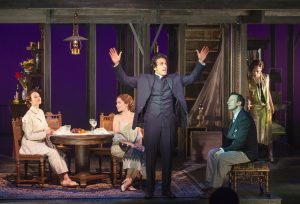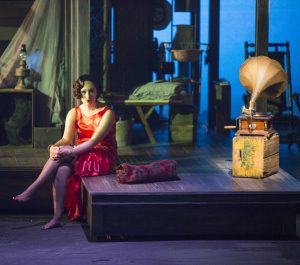Music No Help In the Struggle For Sadie’s Soul at the Old Globe
The main question to ask about the new musical at the Old Globe Theatre, and there aren’t many worth pursuing, is “why?”
Why spend any effort on a musical version of W. Somerset Maugham’s antique novella Rain, which treated issues of cultural imperialism rampant in those days, but nudged aside by new horrors now?
The piece used to be endlessly adapted for stage, screen and whatever mainly because if offers hefty opportunities for scenery-chewing to actors who of the larger-then-life variety. Now, though, it’s past time to give the tale an honorable retirement.
The setting is tropical Pago Pago in 1924, the characters are a random scoop of Anglo-Saxon tourists quarantined temporarily by a measles outbreak among the crew of their island-hopping steamer.
The rules of the game are archaic: White folks are automatically catered to, men rule, missionaries are powerful even beyond colonial governments, natives are noble savages and dressing for dinner is required.
It’s that bit about the missionaries that sets up the main event. One of the passengers is in fact a missionary, a proselytizer of the most tiresome type, and when he discovers that the sultry female passenger, travelling alone, is a loose woman probably on the lam from the law in the States, he sees his duty clearly.
As the dismal days of endless rain stretch on, he struggles to rescue the soul of this Sadie Thompson, his captive because the island governor just wants her gone on the next available ship, which is heading for San Francisco. She plays her Victrola until the preacher smashes the record and she has a couple of sailors in for the evening until he smashes them too. Can you spell obsessive?
This being a romantic melodrama of exotic flavors, rational reality hasn’t a chance. Sadie is willing to talk endless God stuff if it keeps her pointed away from jail but the raw emotion being pumped out by the preacher inevitably becomes destructive and sin wins big.
I haven’t read this story in decades but now, though I’m feeling no guilt at insufficient research, I sense tweaking. Sybille Pearson, who adopted Maugham’s story for this musical, also called Rain, has adjusted the piece, I suspect, to make it even juicier for changed tastes. Sadie’s hint of pioneering feminism probably didn’t occur exactly this way to Maugham. The preacher’s dark past may be even darker than ever now. Certainly everybody’s language is more coarse.
But the big contrast between now and then is how very uneven the playing field for this culture clash really is. How slanted were those rules. And how different are the rules today.
Religion has to scratch for influence now. There is such a thing as feminism and it continues to make progress. Race carries little heft compared to wealth. The power to bully comes in all colors. The truth is out there and we’re nearer to it than we were when Rain was new and relevant.
Which brings me back to “why?” Were Pearson and her musical partner, Michael John LaChiusa, suggesting that nothing really changes? Or that changes will instruct by being obvious? Either way, they still get opportunities for heavy breathing and splatterly violence, not to mention a heroine who personifies the power of evil or the survival of innocence or something. My only answer is, so? Attitudes and laws evolve. Passions find their levels. I need more reason to care about this ugly little tale.
The songs certainly are no help. LaChiusa’s preferred approach is a dignified chant over a discreet accompaniment, sort of a very tentative reach-out to hip-hop technique. But often he simply shops through the musical theatre heritage, borrowing from Kurt Weill here, from Rodgers and Hammerstein there and, because he needs a final anthem of defiance from Sadie, from Cy Coleman and Dorothy Fields’ Sweet Charity. There’s nothing illegal about a derivative score but beware the clichés and stereotypes. And the Bruce Coughlin arrangements, sliding from grandiose downward to pompous, don’t help.

Left to right, Elizabeth A. Davis, Betsy Morgan, Jared Zirilli, Tally Sessions and Eden Espinosa in Old Globe Rain. Jim Cox Photo.
As Sadie, Eden Espinosa has tall, languid presence and not much else. But she’s better off than Elizabeth A. Davis and Betsy Morgan, who play a couple of colorless, ignored and unfulfilled wives, ineffective despite the occasional peens of praise directed their way. Marie-France Arcilla wraps herself in Rousseau’s Nobel Savage act as the island girl taking her white man native.
The men characters are a crippled mess: a loathsome, contemptible bully, a sniveling victim, a dreamy dropout, horny sailors ashore. Tally Sessions at least stays under control is the doctor spooked into drunkenness by the horrors of World War I battlefields. Jeremy Davis is uninteresting as the wandering Scot who has found respite from the world outside.
Jared Zirilli’s missionary is hard to pin down. He makes this jerk so obviously unstable, so smug in his self-righteous menace that it’s hard to class the character as human. Some sliver of interesoutside his religious mania – humor is too much to ask – might make him a human and worth pity. But this monster is just a stain that needs obliteration. A powerful performance in some ways but one with no room for tempering ambiguity.
The most praise-worthy element of the physical production is sound designer Ken Travis’ thunder. The rain is supposed to be an endless water torture rubbing passions raw so forth, but after a bit of spirited dripping around the edge, it retreats into swirls and eddies in the top corners of the stage picture.
The multi-level hotel that dominates Mark Wendland’s set is an elaborate, clunky Rubik’s Cube affair that has no personality, just complications. Eventually, it grinds open, supposedly to reveal the ocean, but the view could also be a polluted plain near East Orange, NJ. There’s simply no sense of place in all this, no hint (for example) of anything tropic. And Russell H. Champa’s lighting design is no help, alternating between vague haze and cruel area spots. If ever a show cried out for scenic projections, this one is it.
There are a couple of moments than are more winning than the rest. The doctor’s wife and the native lady sing a duet – “The English Lesson” – that could fit right into South Pacific. Espinosa finds some toeholds in Sadie’s survival song, “Thirteen Dollars.” And somebody has a pungent pun about Santa’s helpers (subordinate clauses). Not nearly enough, though.
Keep the show and give us the precipitation. For the tropic vegetation. Outside.
Continues in the Old Globe Theatre at 7 p.m. Sundays, Tuesdays and Wednesdays, at 8 p.m. Thursdays-Saturdays and at 2 p.m. Saturdays and Sundays through May 1, 2016.

Welton Jones has been following entertainment and the arts around for years, writing about them. Thirty-five of those years were spent at the UNION-TRIBUNE, the last decade was with SANDIEGO.COM.




quite a withering review, Welton, but alas, pretty right on after I saw one of the previews…
Just some strong songs would’ve helped much!